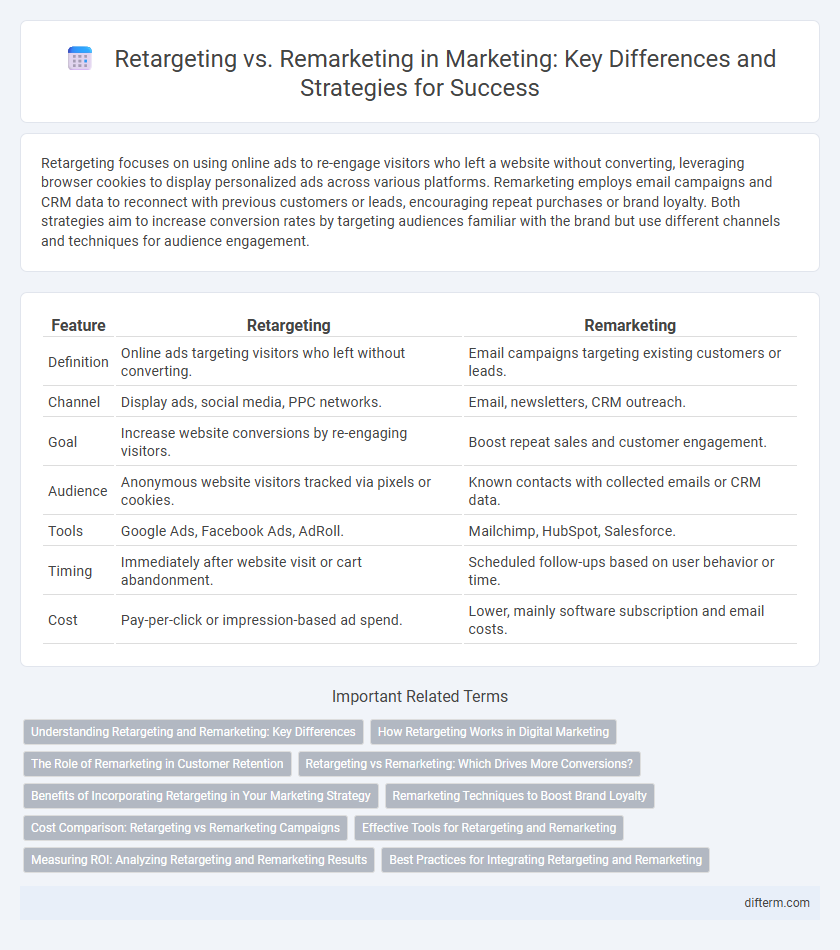Retargeting focuses on using online ads to re-engage visitors who left a website without converting, leveraging browser cookies to display personalized ads across various platforms. Remarketing employs email campaigns and CRM data to reconnect with previous customers or leads, encouraging repeat purchases or brand loyalty. Both strategies aim to increase conversion rates by targeting audiences familiar with the brand but use different channels and techniques for audience engagement.
Table of Comparison
| Feature | Retargeting | Remarketing |
|---|---|---|
| Definition | Online ads targeting visitors who left without converting. | Email campaigns targeting existing customers or leads. |
| Channel | Display ads, social media, PPC networks. | Email, newsletters, CRM outreach. |
| Goal | Increase website conversions by re-engaging visitors. | Boost repeat sales and customer engagement. |
| Audience | Anonymous website visitors tracked via pixels or cookies. | Known contacts with collected emails or CRM data. |
| Tools | Google Ads, Facebook Ads, AdRoll. | Mailchimp, HubSpot, Salesforce. |
| Timing | Immediately after website visit or cart abandonment. | Scheduled follow-ups based on user behavior or time. |
| Cost | Pay-per-click or impression-based ad spend. | Lower, mainly software subscription and email costs. |
Understanding Retargeting and Remarketing: Key Differences
Retargeting primarily uses online display ads to re-engage visitors who have interacted with a brand's website but did not convert, leveraging cookies and pixel tracking for precise audience targeting. Remarketing focuses on reconnecting with customers through email campaigns or personalized messages based on previous interactions, aiming to nurture leads and drive repeat purchases. Understanding these differences helps marketers optimize budget allocation between broad ad targeting and personalized follow-ups, enhancing overall campaign effectiveness.
How Retargeting Works in Digital Marketing
Retargeting in digital marketing uses tracking pixels and cookies to identify users who have visited a website but did not convert, enabling advertisers to display personalized ads as these users browse other sites. By leveraging real-time data and behavioral insights, retargeting campaigns increase brand recall and drive higher conversion rates through targeted ad placements on platforms like Google Ads and Facebook. This method efficiently nurtures potential customers along the sales funnel by delivering relevant messaging based on their previous interactions with the brand.
The Role of Remarketing in Customer Retention
Remarketing plays a crucial role in customer retention by targeting previous website visitors with personalized ads that reinforce brand recall and encourage repeat purchases. This strategy leverages user behavior data to deliver relevant content, increasing the likelihood of converting window shoppers into loyal customers. Effective remarketing campaigns can reduce churn rates and boost lifetime customer value by maintaining ongoing engagement across multiple digital channels.
Retargeting vs Remarketing: Which Drives More Conversions?
Retargeting leverages behavioral data to deliver personalized ads across multiple platforms, significantly increasing conversion rates by re-engaging users who have previously interacted with a brand. Remarketing typically uses email campaigns to reconnect with past customers but has limited reach and impact compared to dynamic retargeting ads. Studies show retargeting campaigns can boost conversions by up to 147%, making it the more effective strategy for driving sales and customer engagement in digital marketing.
Benefits of Incorporating Retargeting in Your Marketing Strategy
Incorporating retargeting into your marketing strategy significantly increases conversion rates by re-engaging visitors who have previously interacted with your website or ads but did not complete a purchase. Retargeting campaigns deliver personalized ads based on user behavior, enhancing brand recall and driving higher click-through rates compared to standard display ads. This targeted approach maximizes advertising ROI by focusing budget on a qualified audience more likely to convert, ultimately boosting revenue and customer retention.
Remarketing Techniques to Boost Brand Loyalty
Remarketing techniques such as personalized email campaigns, dynamic ad placements, and exclusive offers effectively rekindle customer interest and foster brand loyalty. Leveraging customer data to deliver tailored content enhances engagement and drives repeat purchases. Integrating multi-channel remarketing strategies ensures consistent brand presence, boosting long-term customer retention and lifetime value.
Cost Comparison: Retargeting vs Remarketing Campaigns
Retargeting campaigns typically incur lower costs due to automated ad delivery focused on users who have shown prior interest, resulting in higher conversion rates and reduced ad spend. Remarketing often involves personalized email marketing and direct outreach, which may increase operational expenses but yield better engagement through tailored communication. Evaluating ROI requires balancing the efficiency of retargeting's programmatic ads against the personalized impact and higher per-contact cost of remarketing efforts.
Effective Tools for Retargeting and Remarketing
Effective tools for retargeting and remarketing include platforms like Google Ads, Facebook Ads, and AdRoll, which use pixel tracking to deliver personalized ads to users who have previously interacted with a brand. Dynamic product ads and customer list targeting enhance engagement by showing relevant content based on browsing behavior and purchase history. Leveraging CRM integration and machine learning algorithms optimizes campaign performance and maximizes return on ad spend.
Measuring ROI: Analyzing Retargeting and Remarketing Results
Measuring ROI in retargeting and remarketing campaigns requires precise tracking of conversion rates, click-through rates (CTR), and customer lifetime value (CLV) to evaluate effectiveness. Retargeting often shows higher immediate engagement due to ad placement on external sites, while remarketing tends to drive better conversion through personalized email campaigns and tailored messaging. Utilizing analytics platforms like Google Analytics and CRM data helps marketers compare performance metrics and optimize budget allocation for maximum return on investment.
Best Practices for Integrating Retargeting and Remarketing
Integrating retargeting and remarketing campaigns requires precise audience segmentation and personalized ad creatives to maximize engagement and conversion rates. Leveraging data analytics platforms like Google Analytics and Facebook Ads Manager enhances targeting accuracy by identifying high-intent users and optimizing bidding strategies. Consistent A/B testing and frequency capping ensure ad relevance while preventing audience fatigue, driving efficient budget allocation and improved ROI.
retargeting vs remarketing Infographic

 difterm.com
difterm.com